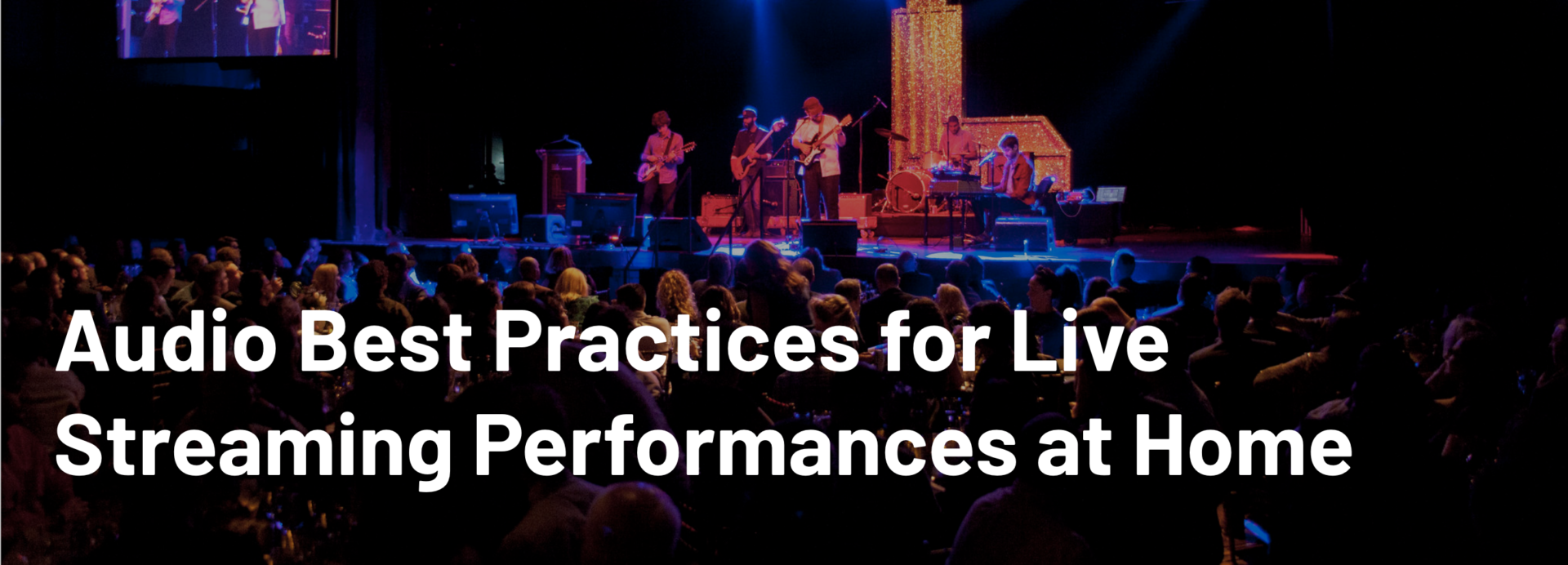With the recent explosion of live-streamed concerts and performances, a common gripe is poor sound quality. But just because you don’t own a fully-equipped home studio doesn’t mean you can’t entertain the masses online.
Below, we give you a comprehensive list of guidelines and best practices on how to get the best sound quality during your live streamed performance. We provide suggestions for specific streaming platforms too (zoom, google hangouts), so we suggest reading through to the end.
Internet
- In general you will want at least 1.5mbps upload speed to livestream video/audio. Try to minimize the amount of bandwidth being used on your wifi for the livestream.
- You can test your internet speed by Googling “Internet speed test” and Google has a built-in test that takes less than 30 seconds to complete.
- Disconnect devices and make sure nothing else is being streamed or is downloading on your network.
- Use ethernet if possible.
Microphone
- Use your laptop’s mic over a headphone mic. You will be able to maintain a more steady position at the appropriate distance away from a laptop mic that is stable versus one that is on your head! You will more likely clip/distort on headphone/earphone mics since the sound source is so close to the mic. The audio will also be more balanced (the volume levels of your instrument AND your voice) using a laptop mic that is positioned a few feet away from you and your instrument rather than on your head.
- If you have a USB mic, (or consider buying one if you want to do frequent livestreams – you can spend less than $100 on a microphone that will improve your audio quality significantly), use it! Read up on specific advice on the mic you are using and use a pop filter if available.
- In your laptop settings, search for the option to use “ambient noise reduction”. Turn this off. This is helpful for spoken conversations but harmful to music.
** The Room
The most important factor is the ROOM you are recording in, and your positioning in it.
- The bigger the better because a larger room will provide a small amount of natural reverb! Smaller rooms will cause slap echo (or a delay with a short time) that will be distorting, sound disorienting and distracting. Big rooms are preferred but don’t record yourself in something the size of a large hall or cathedral…
- Do not record in a square room if you can help it. The more irregular shape the room is, the better. This has to do with the acoustical reflections of sound in a space.
- If you are in a room where this is possible, you will want to put your laptop close to the SHORTEST wall in the MIDDLE of the width of that wall and have the laptop face the room.
- Do NOT have your back against a wall with your laptop close to you. You want as much distance between your laptop screen and the wall your laptop screen is facing as possible, leaving 1-2 feet between the wall and the back of your laptop.
- Stand a few feet away from your laptop and the wall. Air will act as a natural compressor which will help the audio not clip/distort.
- Try to be in a room (or you can easily build this before your livestream) with several different types of surfaces. Sitting on a couch or bed is great (as long as it looks nice), having a carpet is great, and bookshelves are great. Even having things hanging on your walls is helpful. This is because you want absorption (by the soft surfaces) and dispersion (by the rigid, uneven shapes) of the sound (think about how echoey an empty room is). Large areas of hard, flat surfaces – such as walls – are your enemy.
- Make sure your room is quiet. Your laptop mic is most likely omnidirectional or close to it and will pick up sounds from all around you – not just what is in front of the laptop screen.
Additional Advice
- Make sure you test your audio using your sound preferences setting on your laptop BEFORE you stream. Sing/play quietly, and as LOUD as you think you will get to make sure that your full range of volume will not cause clipping. Adjust your gain accordingly. Even record yourself on your laptop first and listen back to see if you can hear noises around the room or distortion.
- If you are using a non-acoustic instrument (such as electric guitar or digital keyboard), record yourself ahead of time and listen back. Adjust the volume of your instrument accordingly to achieve a good balance between your instrument and voice.
- Avoid using backup music. There’s not many situations where this will sound good. It will not translate over the microphone like you may be hearing it in your room. It will sound tinny. There will be no bass and only mids. It most likely will also not be balanced volume wise.
- When using Zoom or Google hangouts, there are default settings that you need to change. Go to settings > Audio > Advanced. You need to turn OFF “suppress persistent background noise” (find the quietest room you have – only use this if there is a lawnmower or something outside), turn OFF “suppress intermittent background noise” (this has the potential to ruin your music quality by crushing all of the audio), and Echo Cancellation – turn on Auto. There is no off option for this one.
Compiled by A2IM’s resident audio nerd Hannah Langtry (MA in Audio Arts) with help from Matthew Gregory Serianni (BM in Music Technology).

